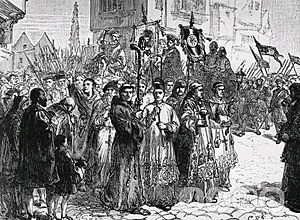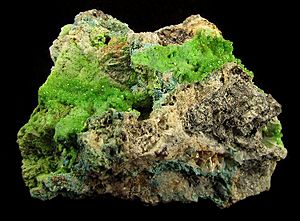Bevis Bulmer facts for kids
Sir Bevis Bulmer (born 1536, died 1615) was a clever English mining engineer who lived during the time of Queen Elizabeth I and King James I. He was known for taking risks and investing in new projects, especially in mining. A lot of what we know about him comes from a book by Stephen Atkinson called The Discoveries and Historie of the Gold Mynes in Scotland. This book used some of Bulmer's own writings, which are now lost.
Contents
Who Was Bevis Bulmer?

Bevis Bulmer was born in 1536. His parents were Sir John Bulmer and Margaret Stafford. Sadly, his parents faced serious trouble when they were involved in a large protest movement called the Pilgrimage of Grace in 1537. Because of this, their lands were taken by the Crown.
Bulmer's Early Mining Adventures
Bulmer started his career in mining at some of his family's old properties in Wilton, North Yorkshire. He was very interested in how iron was melted down, especially at a place called Rievaulx Abbey. He even used ideas from an old book about mining called De Re Metallica by Georg Agricola.
Around 1562, Bulmer started working with lead and calamine (a type of zinc ore) mines in the Mendip Hills in Somerset. These ores were important for a company that made metal goods. Bulmer also helped with smelting operations (melting ore to get metal) in other places.
Bulmer's Work in the 1580s
Around 1581, Bulmer traveled to Ireland to see silver mines there.
In 1584, Bulmer was given permission to build lighthouses, which help guide ships. He also helped check the value of gold found on a captured Spanish ship.
The Combe Martin Silver Mine
In 1587, Bulmer got involved with a silver and lead mine in Combe Martin, Devon. He worked with Adrian Gilbert, who was the brother of a famous explorer, Sir Humphrey Gilbert. Bulmer took on the job of running the mine and paying for everything. The mine, called Fayes Mine, was very deep and wide.
At first, the mine was very successful, making a lot of money for Bulmer and Gilbert. However, the amount of silver they found later dropped. Two famous bowls were later made from the silver found at Fayes Mine.
In 1586, Queen Elizabeth I supported Bulmer's silver and lead mining efforts in the Mendip Hills. However, the Queen ended up losing money on this project.
In 1588, Bulmer received a special permission to use a water-powered machine to make nails. This was a new and efficient way to produce nails.
Bulmer's Projects in the 1590s

In 1593, Bulmer built a pump to bring clean drinking water from the River Thames to Cheapside in London. This was a big project that finished in 1595.
Searching for Gold in Scotland
Also in 1593, Queen Elizabeth I recommended Bulmer to the Scottish government. He became the Master of Works for Ores in Scotland, meaning he was in charge of mining operations. He was given permission to search for gold and silver in Leadhills in Lanarkshire, Scotland.
From 1594, Bulmer worked with Thomas Foulis, an Edinburgh goldsmith who made jewelry for King James's wife, Queen Anne. Stephen Atkinson wrote about Bulmer's work in Scotland, describing how he found a lot of "small mealy gold" and even "greatest gold" that looked like "Indian wheat." Atkinson noted that Bulmer was very generous and gave away a lot of gold, which meant he didn't become as rich as he could have been.
When Bulmer returned from Scotland, he gave Queen Elizabeth I a special gold cup. The Queen liked the gift so much that she made him one of her trusted servants. As a reward, she gave him the right to collect taxes on coal brought by sea and on imported wines. He also offered a large sum of money to control the sale of all tin produced in Cornwall.
After his time in Scotland, Bulmer wrote a book about his mining experiences called Bulmer's Skill. Unfortunately, this book was never printed and is now lost.
Bulmer's Later Years (1600s)
In 1603, King James I and Bulmer came up with a plan to get people to invest in gold mining in Scotland by making them "Knights of the Golden Mines." This idea didn't work out. However, Bulmer himself was knighted in 1604.
With money from the King, Bulmer went back to Scotland in March 1605 to search for gold in the Lowther Hills. He had many workers at different mining sites. In 1606, the King gave him the right to mine all gold and silver in Scotland, and he received more money from the King in the following years.
In February 1607, a rich silver deposit was found near Bathgate, Scotland. Bulmer and Thomas Foulis opened a mine there called "God's Blessing." King James bought the land and put Bulmer in charge, giving him money to run the project. However, this mine also turned out to be a financial failure within two years.
In 1611–12, Bulmer was involved in mining in Kilmore, Ireland. Stephen Atkinson, who wrote about Bulmer, said he spent two years working with Bulmer in Ireland.
Bevis Bulmer later returned to England and passed away in 1615.
Family Life
We don't know much about Bulmer's marriage. He had a son named John Bulmer, and three daughters: Elizabeth, Prudence, and another daughter also named Elizabeth.
His daughter Prudence Bulmer married John Beeston in 1596. After John's death, she married Patrick Murray in 1603.
Images for kids
-
Depiction of the Pilgrimage of Grace
-
Specimen of lead ore from the Leadhills mines
-
The Lowther Hills, where Bevis Bulmer searched for gold on behalf of James I





